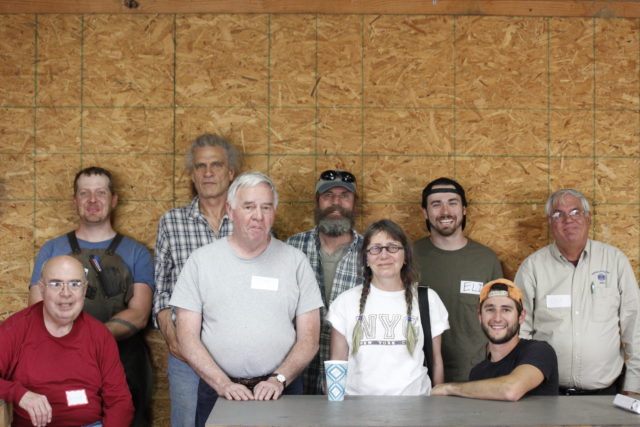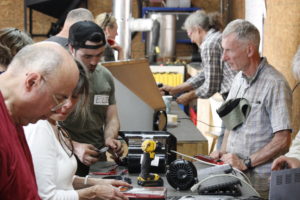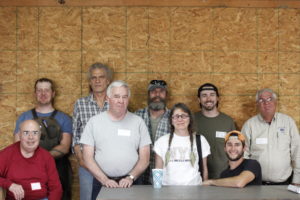
It’s been over a year since our last blog post, but the Biochar Facility at Living Web Farms is still a busy place. In addition to keeping our batch biochar retort system in production we’re constantly exploring the nexus of all things sustainable technology and regenerative agriculture. Our 2020 workshops are covering a boggling range of material, but there is one often unmentioned common thread among all of Living Web Farms’ work: building community resilience. Our decision to organize a Repair Cafe program was born out of this mission.
A Repair Cafe is an event where you’ll find volunteers with tools and supplies, available to fix broken household objects at no cost, while offering instruction in the form of hands-on help. We started hosting WNC Repair Cafe in 2018, and since then I’ve seen many reasons why people bring us their broken stuff. It’s a free service, so saving money is certainly on many people’s minds. Many may come with a sense of environmental stewardship or old-fashioned thriftiness and intuitively sense something wrong with throwing something in a landfill that may still have some use. Some have heirloom objects and don’t know where else to go. Repair Cafes work on deeper levels too: if you visit one you’ll see it’s about sharing the skills and building confidence to take on repairs of your own. In the context of consumer-debt driven economy, riddled with planned obsolescence and a throw-away culture, Repair Cafes are all about building community resilience.
Repair or Replace?
So as someone who thinks this hard about repairing something like ordinary household appliances, you can imagine the mental tug-of-war I experience when it comes to deciding whether to purchase new or repair an existing car.
For most of us, purchasing a new car is a big decision that is often rationalized in a (perfectly legitimate) financial context. Depreciation alone dictates it never makes sense to buy new. In nearly all cases, when weighing repair costs against a new monthly payment, keeping an old car on the road is going to save money. Especially, if one is willing to go after some repairs on their own.
Maybe you’re willing to take on simple home repairs but spooked about the idea of working on cars? Did you know that auto parts stores will often scan your check engine light and loan specialty tools at no cost? Model-specific online communities are increasingly helpful for diagnosing problems and, of course, YouTube has been amazing for walkthrough DIY repair tutorials. Using all three of these resources, replacing the knock sensor on my 1999 Forester was brazenly simple and helped me through another annual North Carolina vehicle safety inspection for what eventually was its final year on the road.

Transmission problems were too much for my 1999 Forester. This photo was taken days before Working Wheels salvaged it for parts.
So how to compare the environmental costs of driving old low-mileage cars versus newer, more efficient cars? From a carbon footprint standpoint we know the manufacturing of new cars is a carbon-intensive process. However, it turns out this kind of carbon accounting is a lot more complicated than replacing a knock sensor. The process of assessing the environmental impact of materials processing, manufacture, distribution, use, and disposal of a product is done with a Life Cycle Analysis. And though accounting for the amount of detail that goes into a ‘perfect’ LCA is ultimately impossible, even an imperfect LCA can be useful as a guideline for making decisions as an environmentally driven consumer. Distribution and disposal factors are largely dependent on an end user’s geographic location. Environmental impact from use can be incredibly variable. So by focusing exclusively on just the energy required for materials processing and manufacture – or, embodied energy – we can begin to understand how our new purchases can affect our carbon footprint.
For example, let’s take a closer look at the embodied energy of a typical American-style refrigerator with an estimated embodied energy of 1639 kWh. Let’s assume that a typical 10 year old 22 cu.ft. refrigerator consumes 600 kWh/year. Trading the refrigerator in for a new 20% more efficient refrigerator could save 120kWh/year in personal electrical costs, but when factoring in embodied energy, these savings could take over 13 years to completely recoup its manufacturing footprint! Not a huge gain, considering that typical refrigerators have an average expected lifespan of 14 years.
Additionally, though many major appliances have been steadily becoming more energy efficient, the increased number of these appliances in the home has outpaced any efficiency gains. New purchases for the sake of saving energy at home should be weighed against the total global environmental costs from the manufacturing process.
So with this in mind, let’s revisit my question of whether to repair or replace my car. Embodied Energy data on specific appliances or automobiles isn’t readily available information, but we can estimate these figures too. Quoting from the Translational Ecology blog:
“Across a range of size, the energy it takes to manufacture a new car is equivalent to about one year of the energy used to power it.”
“If you plan to keep a new car 5 years, it should get 20% better gas mileage than your old car if you want to approach environmental neutrality in your decision to buy. If you will keep a new car 10 years, then you only need to get 10% better mileage.”
In the spring of 2019 I was observing an average 20 highway MPG in my 20 year old Subaru Forester. The Forester had been remarkably reliable since a head gasket replacement in 2012, though I had become increasingly aware that I could do better for my 29-mile, mostly highway commute. Planning to keep a new car for 10 years I would only have to aim at 22 MPG to break even on accounting for embodied energy. Given the sheer amount of energy consumed in my use of driving a personal car for 15K miles per year, breaking even on fuel standards of a 20 year old car was easy. Repeatedly replacing a new car after five years would be a much different scenario.
Our family’s decision to drive a 2015 Ford C Max Plug-In Hybrid with a 20 mile electric range was, in part, motivated by a decision to do better than break even on gas mileage. My gas mileage on gasoline alone is wildly improved, the ride is more comfortable, and for now I’ve got a 21st-Century stereo. It’s a major upgrade, and I’m very thankful to have it. But one can’t forget the ethical issues surrounding mining practices for the raw material in the lithium batteries it uses. Electric car drivers that boast of zero emissions have also been criticized for offsetting their pollution from the tailpipe to the power plant. Ideally I would be set up for solar charging at home, but Asheville’s switch to natural gas gives me some relief that I’m not driving a coal powered vehicle for the 60% of my commute that is powered off the battery.
As someone who is used to fixing my own stuff, perhaps most concerning for me is the growing disparity among newer cars between what can be repaired at home and what requires dealership intervention. What needs to work, and what are gimmicky ‘bells and whistles’ may be too closely linked, and the resulting exorbitant repair costs may guide consumers to prematurely reach the decision that ‘it’s not worth fixing’. As a result, insurance costs are rising and people are working harder for things they don’t need. This is a concerning and familiar trend. It is one of the many faces of planned obsolescence.
In a blog post of their own Carfax casually tells us:
“Because your vehicle has common features such as a rearview camera and LED taillights, and those are damaged, you’re facing $3,000 worth of repair costs.”
Planned obsolescence
It is widely known that Henry Ford developed the moving assembly line, significantly reducing costs and for the first time making the prospect of automobile ownership widely available to ordinary Americans. Not so widely known is that only a few years later, General Motors, under the direction of Alfred P. Sloan, (yes, the same Alfred P. Sloan as in the NPR sponsorships) introduced the concept of the “model year”, in which annual, and often petty, stylistic changes to last year’s model masquerade as meaningful technological improvements. This practice in itself is a form of planned obsolescence, albeit using social and psychological means to achieve the same end: encouraging the replacement of a product before the full extent of its useful life is realized. This combination of mass automobile ownership at the dawn of a competitive, throwaway culture has had a massive impact on the way we approach our material world.
If you’re like me, then you’ve always assumed the term “planned obsolescence” refers specifically to the practice of intentionally inferior engineering for the purpose of driving sales.
An often cited tale is that of the Phoebus Cartel. This is the true story of a consortium of light bulb manufacturing executives from all around the world who met in Geneva in 1924 to discuss mutually agreed upon limits to hours of operation and production quotas for the world’s light bulbs. When contrasted against reports of the centennial bulb of Livermore, California where a hand-blown light bulb has been in operation for 117 years, this lightbulb conspiracy serves as a textbook example of the sort of planned obsolescence we have come to expect: the act of subversively engineering a shortened lifespan into common consumer products. This narrative is easy to believe. During these early years of mass consumerism, planned obsolescence was even openly discussed as a plan for recovering unemployment gains during the Great Depression. And even in recent times, programs like ‘Cash for Clunkers’ have been simultaneously touted as a means for building markets for more efficient cars, and alternatively criticized as another example of government sanctioned obsolescence.
Subversive planned obsolescence does still exist. Though in truth, a closer look reveals that clear-cut examples of this kind of intentional engineering of inferior products for the sole purpose of driving sales are very hard to find. For example, the often repeated tale of DuPont nylon stockings that were engineered to “ladder” prematurely may be entirely rooted in rumor. Giles Slade writes in Made to Break about how, while appealing to anti-Japanese-silk patriotism, DuPont’s team had first generated unforeseen demand in the new artificial product, and then later responded to changing fashions by offering sheer (and thus more fragile) alternatives to the original seemingly indestructible heavy styles of the pre-war era. In later years, by appealing to – and in part, manipulating – fashion trends, the company had effectively rendered a lifetime product into one that warrants new purchases based on satisfying people’s demand for changing styles.
To single out one company or focus only on a particular industry is to miss the point.
The consumer-driven economy of today very well may be built less on products that are designed to intentionally fail and more on those that will go out of style. By appealing to psychological forms of obsolescence, marketing trumps engineering, and product designers are encouraged to build cheap-to-replace products. In turn, these products are not built to last forever, but rather just long enough for a fashion cycle.
Breaking the Cycle
The first Repair Cafe was held in October 2009 in Amsterdam, and was so successful that founder Martine Postma continued organizing several Repair Cafe meetings at different locations throughout Amsterdam. By 2010 she had founded the Repair Cafe Foundation. Now there are over 2000 Repair Cafes operating on six continents.
In the media, Repair Cafes are often touted as a means of preventing one’s household goods from going to the landfill. When a daunting 569 million tons of demolition and construction waste alone were generated in the USA in 2017 – an estimated 40% of landfill volumes – keeping a few appliances out of the landfill may seem insignificant. However, on a personal level, the impact of saving money while gaining the confidence to take on repairs of their own can be very significant. Volunteers with technical skills that are not always seen as valuable have an opportunity to give back, by passing on their knowledge to those that can appreciate it. The community shift away from throwaway culture emboldens professional repair shops, and helps create markets for spare parts. Ultimately, consumers may demand products that are built to last and marketing departments will respond.
It’s on a community scale where Repair Cafes are most effective at organizing grassroots resistance to the throwaway culture. They are places where questions are asked – “should I repair or replace?” – and where nuanced conversations about sustainability and resilience are the result.



